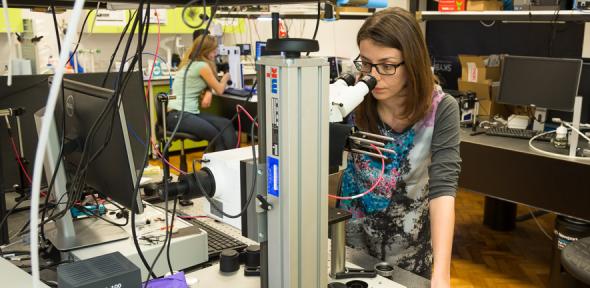
Dr Silvia Vignolini, Lecturer and Group Leader
Silvia has always preferred studying science and maths over other subjects, so she concentrated on science in Florence, Italy, where she went to high school. This preference for science developed into a lifelong passion as a result of an unusual assignment from a particularly inspirational Chemistry teacher. He brought a big pile of books into class and told everybody to choose one to read and report on.
From this pile of books, Silvia ended up reading A Brief History of Time by Stephen Hawking. As she read the book, she became inspired and frustrated in turn, because the science in the book was at a much higher level than she had been taught so far.
Instead of giving up, Silvia contacted a friend who was studying Physics as an undergraduate, who helped her to understand the unfamiliar concepts. This sparked Silvia’s enthusiasm even further. She started reading more about science and the life of scientists, including one of the most famous Italian scientists of all, Galileo Galilei. (Life of Galileo by Bertolt Brecht).
At the end of high school, it was a clear decision for Silvia to study Physics at the University of Florence, where her growing interest in research, and especially optics, led to a successful PhD degree.
Postdoctoral experience
After Florence, Silvia decided to join the research group of Prof. Ulrich Steiner at the Cavendish Laboratory in Cambridge as a postdoctoral researcher. At the Cavendish, Silvia’s original interest in pure optics was extended to the optical phenomena of biological tissue, in particular to studying optical properties of plants. During her post-doctoral experience, she investigated, for example, the iridescence phenomena present in flowers and the metallic blue coloration of Pollia condensata fruits (marble berries).
Interface of chemistry, physics and biology
However, the more Silvia investigated these optical phenomena, the more she realised that the specific chemistry of materials strongly determines the nanostructured architectures responsible for these brilliant and iridescent colours in plants.
Silvia delved deeper into the chemistry of the building blocks behind these photonic structures and she studied man-made materials that mimic these natural structures. At the moment, her research is located at the interface of chemistry, physics and biology.
Coming to Chemistry
After a brief period at University College London, Silvia returned to Cambridge, but this time to the Chemistry Department, where she was awarded a Philip and Patricia Brown Next Generation Fellowship. This fellowship provides start-up funding of £50,000 a year for five years. She additionally is holding a BBSRC David Philip Fellowship to study how plants produce structural colours and was awarded an ERC Starting Grant to study how we can use natural materials to fabricate novel photonic structures.
“The Next Generation Fellowship gave me a lot of flexibility at the beginning of my career,” says Silvia. “It allowed me to recruit students and to give them the possibility to go to conferences and present their results. At the same time, it allows me to start my basic research without the pressure to attract immediate funding.”
Silvia says that her current position as a PI and group leader is demanding but very rewarding. “Most jobs demand a different work load than 9 – 5. If you are enthusiastic about something, you want to spend time on this topic, and it’s exciting to know you might come up with something nobody has every realised before.”
It is interesting to ask what would have happened if Silvia had not chosen to read “A Brief History of Time” in high school. However, this choice was the starting point which ultimately led to her successful research career in Cambridge!

